Distance Learning Tips: How To Stay Organized While Teaching Your Kids At Home
THIS POST MAY CONTAIN AFFILIATE LINKS. PLEASE SEE OUR FULL DISCLOSURE POLICY FOR DETAILS.
Just follow these essential distance learning tips and you’ll finally feel organized and ready to teach your kids at home.
Are you trying to jump into homeschooling for the first time? Or maybe your kids are doing distance learning or have to stay home while in school. Whatever the reason, taking on the role of mom and teacher can feel like a big change.
That’s why we decided to chat with a few pros! Experienced homeschooling moms answered our questions and shared their wisdom with us here at Clutter Keeper®. Learn from them how to get organized when you are teaching your kids at home.
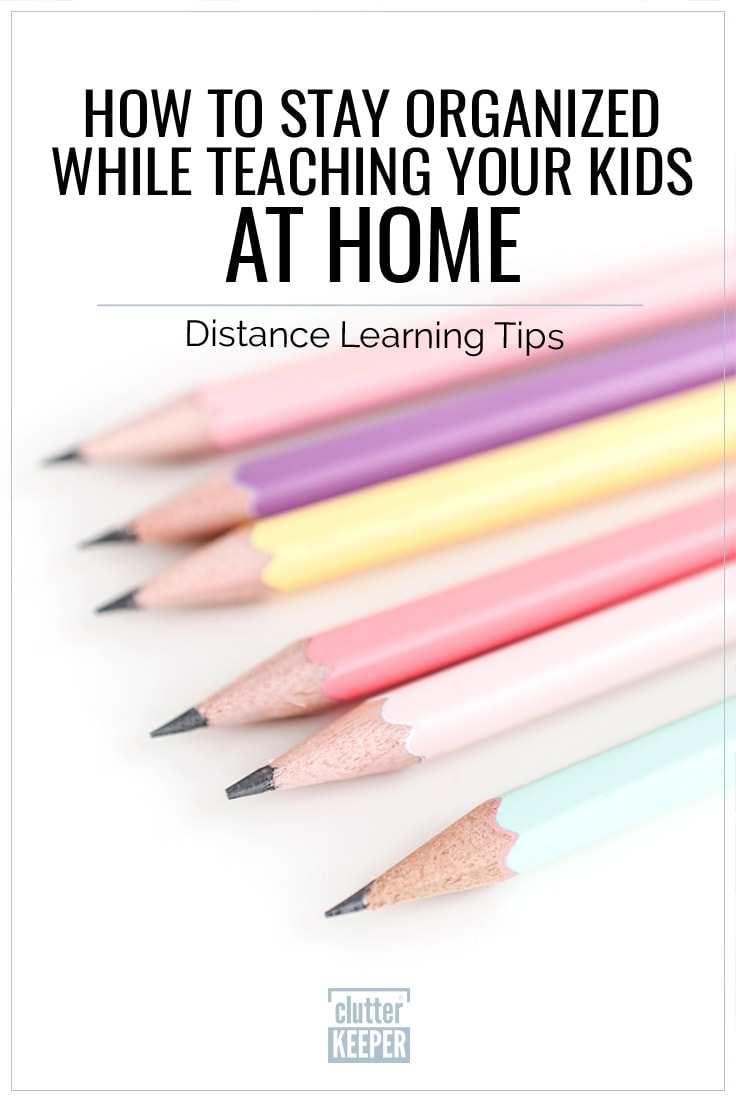
Wondering where to begin? Get our FREE guide, The 30-Minute Organizing Secret, and discover easy ways to overcome the chaos of clutter – even with kids at home!
Distance Learning Tips
What do you struggle with the most when you are helping your kids with distance or online school? Whether it’s keeping track of all their assignments or trying to keep your children motivated, we have tons of tips for you.
Make this guide even more efficient with our Take Action Printables Binder. It has every in it from a meal-planner and printable grocery list. It will help you keep everything you are managing organized and under control.
We spoke with experienced homeschooling parents that have been there and done that. They were more than happy to share a few things they’ve learned from teaching their kiddos full-time at home.
Embrace real-life Learning Experiences
Not everything has to be worksheets and quizzes. In fact, you might discover that the amount of actual schoolwork your kids have to do can be finished in less time than they would actually be in school.
Lots of homeschooling parents use what their kids love to do as part of their educational lessons. It’s like kids are learning without knowing it.

Even something as popular as making slime can be turned into a science lesson. Why is the slime not stretchy enough? What makes it thicker? There is a fun recipe for Cotton Candy Slime on Embracing Homemaking.
Other everyday things like cooking and even cleaning, looking up information about their favorite movie or video game are educational.
Often, we as parents put a lot of pressure on ourselves that doesn’t have to be there. Are you feeling guilty about how much screen time your kids are having when school is out? Then ask them to learn coding and graphic design as part of their day.
Set Up A Clean WorkStation
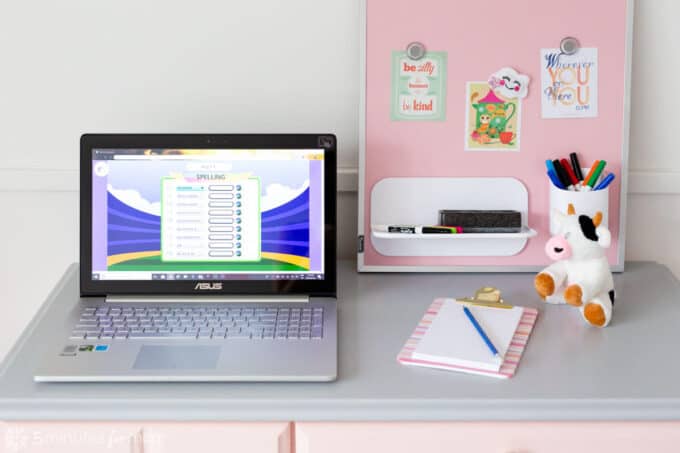
If your kids have lots of work to do at the computer and will need a place to write as well, clean off an area of a desk or the table for them.
Lots of homeschool parents advocate that it’s important to work with your child and create an area that helps them learn how they learn best. If they are an active child that can’t concentrate while sitting at a desk, set up their tablet or laptop on the floor or couch.
Other kids really enjoy the feeling of knowing that their desk is where they do their school work so they can get up and leave it when it’s time to go play. Do what works best for your child.
The most important thing you need to remember is to keep the area – wherever that might be – clean. This will prevent your child from losing important papers and give them fewer distractions too.
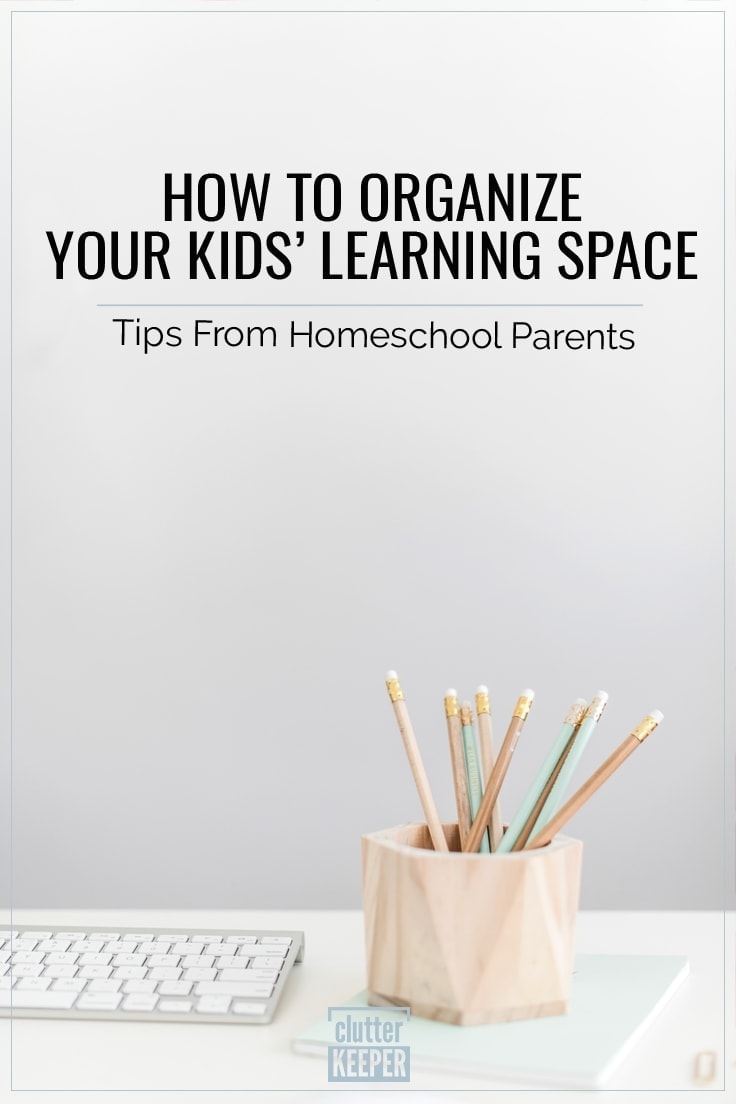
Lots of teachers are setting up classes on Zoom. Others use Schoology or Google Classroom.
Susan from 5 Minutes for Mom shared a program kids love that helps them learn to enjoy reading. It’s called Reading Eggs.
No matter what program they use, a nice laptop and a clean place for your child to work is vital.
Keep All Your School Supplies In One Place
Another one of our favorite distance learning tips is to find one central place to store all your school supplies.
Some people dedicate an entire bookshelf to school books and supplies.
Others, like Her Hearts Homeschool in the picture below, use a mobile cart to store all the supplies.
The important thing is to create one place where everything belongs. This will prevent the school things from piling on top of each other and getting lost.
Write Down All of the Assignments
Whether you have one child or multiple kiddos in school, you are going to have quite a few subjects to keep track of. Things get even more confusing when you are receiving assignments from multiple teachers on different platforms.
Create one central place, like a planner, where you keep all of your child’s weekly and daily assignments.
Ashley from Embracing Homemaking uses a Happy Planner system. “I use this one and add a few pages of my own with a hole punch made for this planner.”
Jen Mackintosh shared on Instagram how she uses the Erin Condren planner to outline the schoolwork for her 3 kids.
Do what works for you. If this means setting up an Excel spreadsheet, do it!
Give A Separate Notebook for Each Subject
Another method of staying organized with schoolwork at home is to dedicate one notebook for each subject. Write down what is due that day for that subject.
This idea is best for kiddos that feel overwhelmed seeing all of their assignments all at once. It helps them focus on one thing at a time.
Give Each child their own notebook
If your children are older or they don’t feel overwhelmed seeing all of their assignments at once, you can give them a planner or even DIY it and create a planner out of an ordinary notebook.
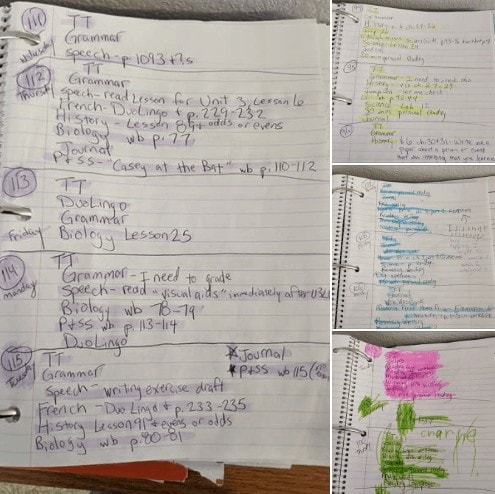
You don’t have to invest in an expensive planner. Jennifer from Real and Quirky explains it like this:
When my kids have finished the work that I have assigned for them, they use a highlighter to indicate that. I like the spiral notebooks that I have for each kid, because I am able to do it the night before or in some cases a few days before if they like to work ahead. I am able to communicate anything with them on there so that I don’t forget between when I thought it and when I talked to them, especially since a lot of times I do this the night before when they are already in bed.
I also like it because they can communicate with me on the spiral notebook as well, by the highlighting and if they want to write a note to me about an assignment or something like that.
-Jennifer from Real and Quirky
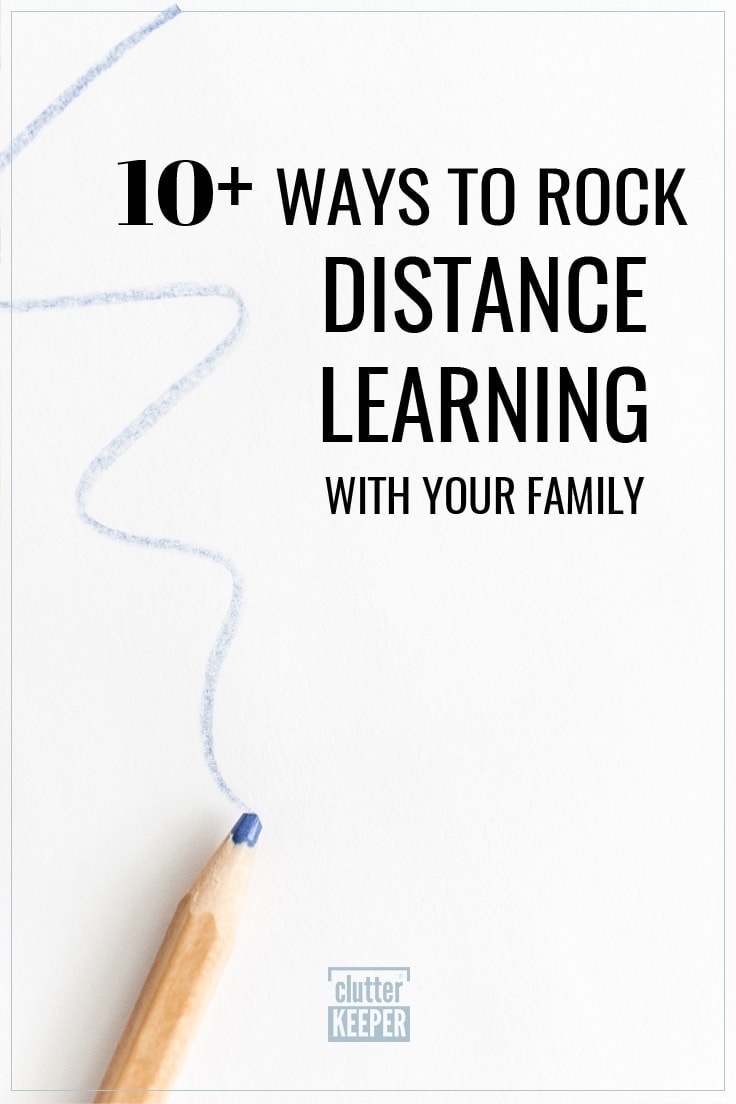
Do Schoolwork together
Some parents enjoy creating an emphasis on different subjects each day. Monday might be a science experiment day, Tuesday arts and crafts day, and Wednesday STEM day.
Even though you might have children in all sorts of different age ranges or abilities, you can still find a way to bond together and do educational activities together.
Bake together. Paint together. Act out a play together. This is the fun part of homeschooling.
Setting up a schoolroom is optional
As we spoke with homeschool parents, it became clear that setting up a classroom with formal desks simply isn’t necessary. You can stay organized and help your child accomplish their work anywhere in the house.
Virginia blogs at That Bald Chick and homeschools three kids ranging in age 8-12. She said in her last home, she homeschooled all over the house.
“Handwriting and group work? Dining room table. Reading? The couch works. Many people don’t have the ability to have a dedicated space, and that’s okay. Just find what works for you, and your family and go for it.”
Jennifer from Real and Quirky agreed that a formal school room isn’t how she does it either.
“A lot of homeschoolers try to copy school at home. They even get desks and put their kids all together there or at tables. My kids work much better split up and find it way less distracting.”
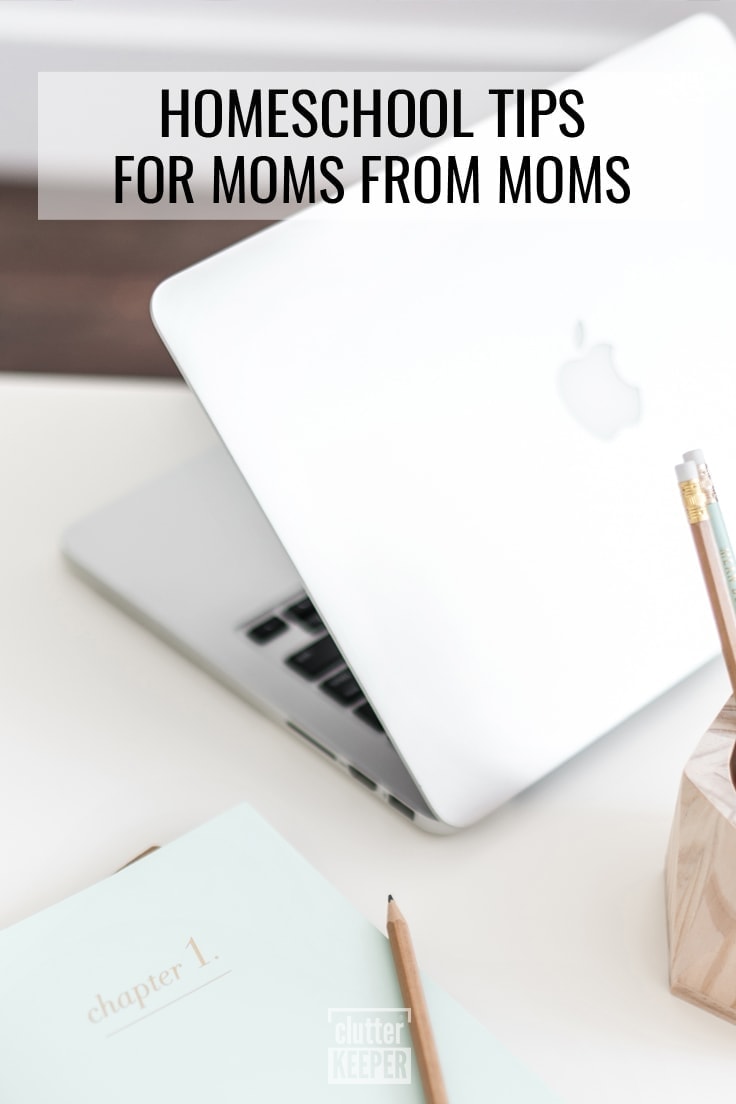
Set Up Routines At Their Level
One thing you might notice your kids missing when they aren’t in school is the comfort of their school routines.
Find a way to create a loose routine your children can rely on. It can be as loose as this:
- Breakfast
- School
- Play
- Lunch
- Play
- Quiet Time
- Dinner
You don’t have to plan out every single hour of your day.
Ashley from Embracing Homemaking describes her day like this: “my kids are 6 and 8 so I don’t have them keeping track of anything on their own just yet. We do have a routine we go through that changes each day of the week and they’re aware of that.
Make the computer area kid-friendly
Do your kids have school or classwork online? If you can, set up a computer for them somewhere that is distraction-free.
Some homeschoolers – like Virginia – set up the computers in one room together like in her picture below. Tour Virginia’s homeschool room. It’s drool-worthy!
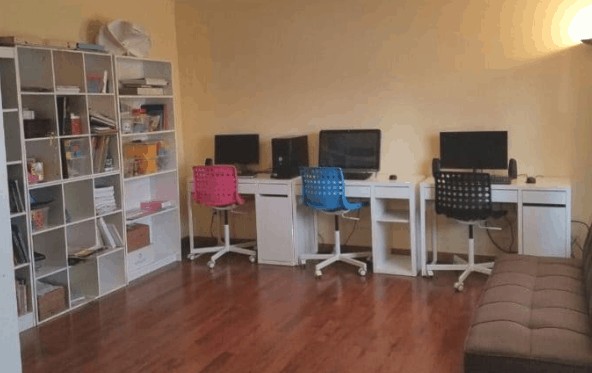
Other homeschoolers admit that trying to put her kids in the same place together is asking for trouble so they set up laptops in different rooms.
Do what works for you and your kids.
Keep Track of schoolwork Online
If your children have schoolwork online, you can set up a system that works for you to keep track of it all.
There are lots of different tools out there. Here are just a few ideas:
- Scholaric – This program is designed for homeschoolers. You can use it to create lesson plans and make daily to-do lists for your children. Or, you can simply keep track of their work assigned by other teachers.
- Google Classroom – You can use this to set up different classes that you need to keep track of. Lots of teachers use it for distance learning.
- Google Sheets – Any of the Google drive products can be used to monitor task management. Create a list of assignments and due dates in Google sheets, for example.
- Microsoft Office Suites – This does the same thing as Google Drive, but works seamlessly with Microsoft Office if your child’s teacher uses it.
- Accellus – This is an online academy that provides a curriculum, classes, and grading for homeschoolers. Keep this tool in your toolbox if you want to homeschool someday.
- Gqueues – This is a fantastic task manager. Give each child their own folder and set up assignment reminders for them.
- Asana – Asana is another project management platform. You can make lists of assignments for your kids and they can log in and go through them each day.

Homeschooling Resources
As you dive into teaching your kids at home or helping them with distance learning, you can always use the extra support.
Homeschool parents know this better than anyone.
Virginia has a guide for free resources for home education. As a homeschool blogger, she also has a variety of homeschool articles and free printables on her site.
Ashley from Embracing Homemaking loves podcasts. These are her favorites:
- Simply Charlotte Mason
- A Delectable Education
- Read-Aloud Revival
- Brave Writer
- Schole Sisters
- Your Morning Basket
- Institute for Excellence in Writing (IEW)

A Typical Homeschool day
As parents we are often our biggest critics. Thankfully, we can still give our kids a quality education without creating a rigid schedule.
What does a typical homeschool day look like for other homeschoolers? Here are two examples.
Virginia – That Bald Chick
She has 3 kids, all in grade school. Here’s what a typical day looks like for her family:
“We start our days with a morning meeting. In the morning meeting, we review the day, the weather forecast, our plan for the day, and any special activities that may be coming up. We do a combined family devotional, have a time of prayer, and read or listen to a selection of books. Each kiddo is expected to spend 30 minutes reading daily, and they choose whether to do that during the day or in the evening.
Our typical homeschool days look a lot different during this crisis than they did before.
Before, we participated in two homeschool co-ops, had tutoring twice weekly for our daughter with learning disabilities, participated in AWANA, and had weekly swim classes. We would do our math daily, and if it was an “out day”, we’d grab our snacks or lunches and go. We use car time to listen to audiobooks, audio dramas, etc.
For “in days” we would complete our assignments that we needed for the upcoming co-op and any other activities I assign, like handwriting, math games, independent coding work, etc.
Now, since we’re not going out for all of our activities, we complete our daily assignments, check Facebook and email for any updated assignments from our co-op teachers.
One kiddo was taking a Radical Readers class at co-op, exploring all kinds of fun books. Her co-op teacher is posting daily videos of herself reading the next book in the lineup and giving assignments that can be done with things we have on hand. We’re making arrangements with other co-op teachers to get their semester projects and continue them at home.
We have also been checking out some of the free resources being made available. For example, each of my kiddos takes an art class at co-op. Now we’re doing the Lunch Doodles with Mo Willems. We’re filling in some of the time with board games and outdoor play.”

Crystal Green – Sharing Life’s Moments
Crystal writes at Sharing Life’s Moments and teaches 3 kids at home ages 8-16. This is what a typical homeschool day looks like for her:
“We get up around 9 am. Then we start schoolwork around 10:00 am. They typically do schoolwork 3 days a week till about 2-3 p.m.
Then the other days they work on projects with my husband or father-in-law. They do woodworking and work on house repair projects.”
It’s Ok To Be Un-Scheduled
The beauty of homeschooling is that you are able to tailor the teaching directly to the specific needs of your child. If you are doing distance learning, communicate any struggles you are having with their teachers and work out a plan that helps your child.
Virginia said her favorite thing about homeschooling is that she can teach her children in the way they learn best. “They all have different needs, different learning styles, different interests, and dreams. We school to the child.”
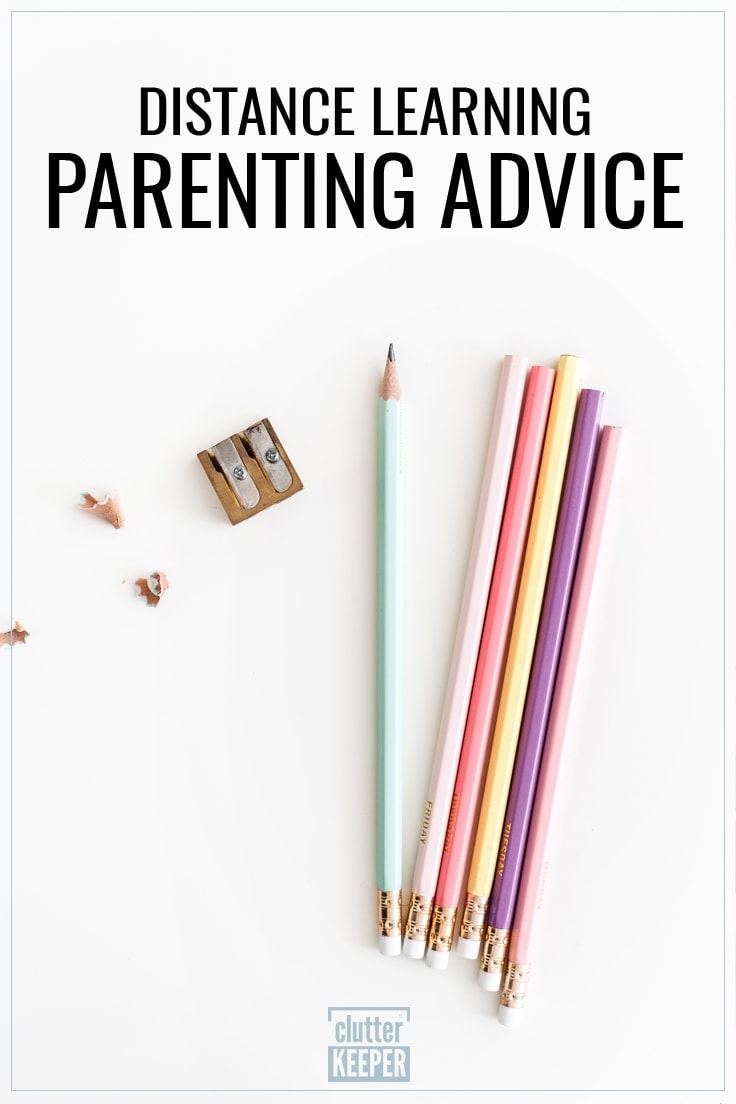
Distance Learning Tips – Fit it into your life
The most important thing to remember is to find a way to make school fit into your life. Use everyday experiences and their own passions to teach them relatable and hireable skills.
Crystal from Sharing Life’s Moments said, “You can teach every aspect of your daily life. You can teach a lot in a car, while cooking, and every other everyday activity.”
Virginia agrees. She shared examples of her kids and how their individual passions lead to what she teaches.
“We have one that is interested in computer technology and gaming, so he’s programmed a Raspberry Pi and is taking a coding course. We have one that is passionate about all things animal, so we watch nature programs and read a ton about different species, their habitats, and the threats against them. We have one that learns with movement, so we do a lot of activities that we pair with learning (jumping jacks while skip counting, etc). We have one that has dyslexia and dysgraphia. We only correct spelling if we’re working on spelling. We use a lot of audiobooks and Google docs for writing. ”
When kids pursue their passion, they’re eager to learn. So what if that passion changes. Change with it. Don’t do it in the other order.
-Virginia, That Bald Chick
Struggling to get motivated? Sign up to get our FREE guide, The 30-Minute Organizing Secret, and discover easy ways to overcome the chaos of clutter – even with kids at home!
More Family Organizing Resources
Keeping your family organized is a full-time job. After you read these distance learning tips, here are some more resources to help you out.
